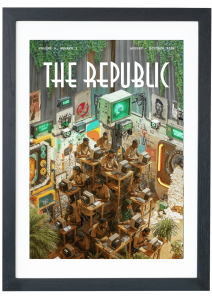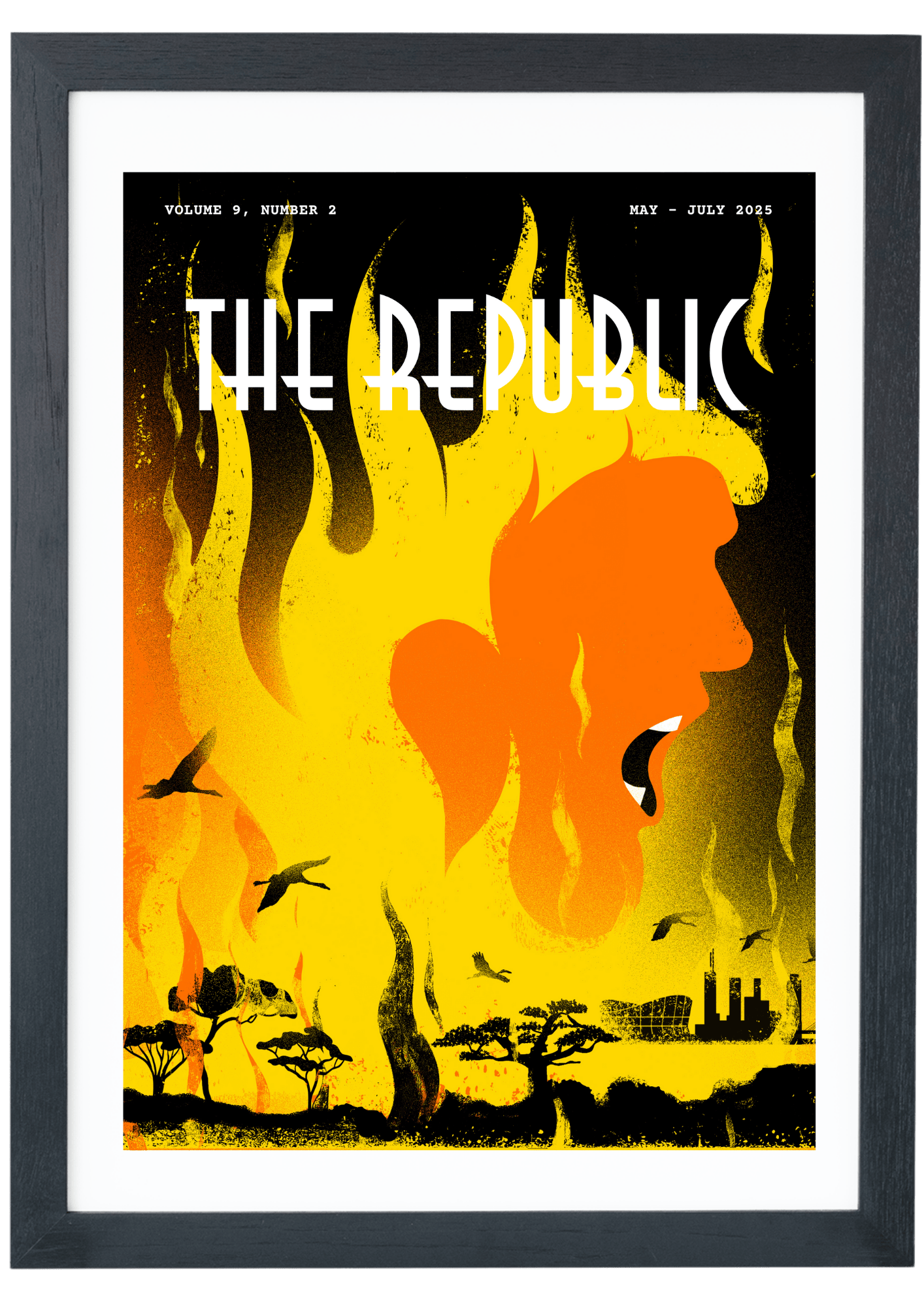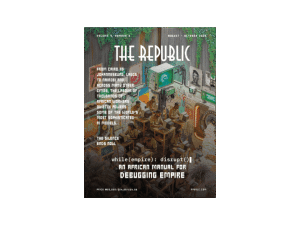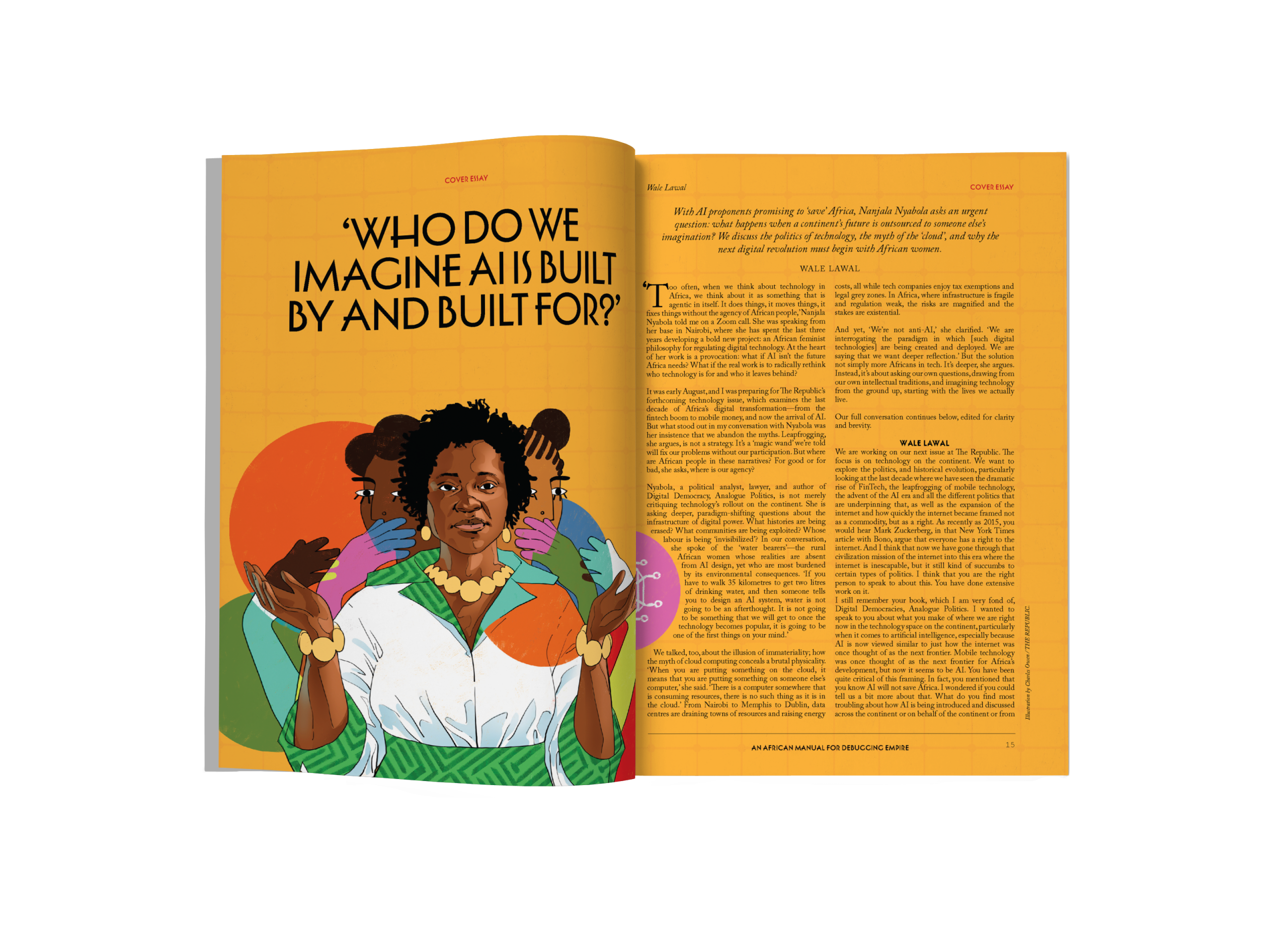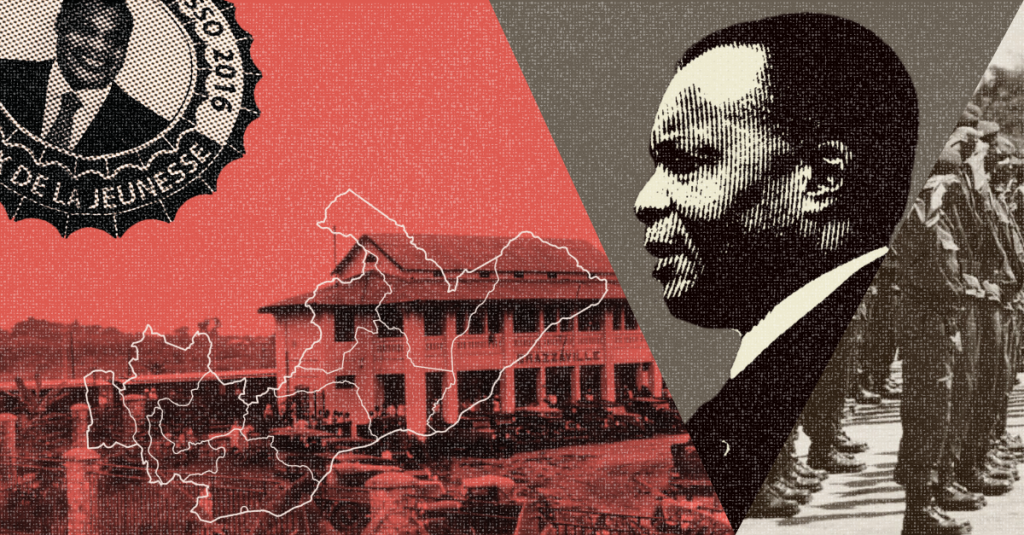
Photo Illustration by Ezinne Osueke / THE REPUBLIC. Source Ref: WIKIMEDIA.
THE MINISTRY OF MEMORIES / DISPATCH FROM CONGO
The Rocky Independence of Congo-Brazzaville

Photo Illustration by Ezinne Osueke / THE REPUBLIC. Source Ref: WIKIMEDIA.
THE MINISTRY OF MEMORIES / DISPATCH FROM CONGO
The Rocky Independence of Congo-Brazzaville
As the Republic of Congo marks its 65th independence anniversary, the country notably remains under the tight grip of President Denis Sassou Nguesso. A Maoïst soldier turned enduring strongman, Nguesso first seized power in 1979, ceded it under electoral pressure in 1992 to Professor Pascal Lissouba, then reconquered Brazzaville by force in 1997. In the six decades since independence, the country has travelled from French colonial rule to Marxist-Leninist mono-partyism, through an aborted experiment in pluralist democracy, and back to an oil-fuelled autocracy. Communist slogans have long faded away; yet, the architecture of rule they established—centralized authority, single-party hegemony and a militarized patronage network—survives almost intact. Once a revolutionary republic forged in Cold War ideologies, Congo-Brazzaville today more closely resembles a family-captured petrostate. The rhetoric of socialism has been supplanted by a vocabulary of modernization underpinned by China’s strategic embrace.
POST-INDEPENDENCE REVOLUTIONARY HISTORY
Post-colonial Congo initially brimmed with nationalist idealism but quickly veered into radical revolution. In August 1963, just three years after independence from France, a popular uprising known as the Trois Glorieuses toppled the country’s first president, Fulbert Youlou. This upheaval opened the door to socialist experiments as Alphonse Massamba-Débat took power, backed by his increasingly authoritarian National Movement of the Revolution (Mouvement National de la Révolution). Captain Marien Ngouabi’s coup in 1968 cemented the alliance of the army and the leftists. By December 1969, Ngouabi proclaimed the People’s Republic of the Congo—the first officially Marxist-Leninist state in Africa—under the aegis of a new vanguard party, the Parti Congolais du Travail (PCT).
The regime raised a red flag emblazoned with a hammer and hoe and embedded the PCT within every state institution. With backing from the Soviet Union and Cuba and training support from China, which modelled youth militias on Mao Zedong’s Red Guards, the new government nationalized key industries and trumpeted revolutionary slogans of emancipation and equality. Despite the ideological fervour, the realities of governing a small, impoverished country soon intruded. Congo lacked the geopolitical weight and resources of some of its socialist neighbours, and it had no protracted liberation war legend to bind its people together. The economy struggled under tribal mismanagement, and restive factions lurked beneath the surface. In 1977, President Ngouabi was assassinated during a period of intense party infighting, officially by a commando that the junta of the time identified as being led by Captain Barthélemy Kikadidi, sparking purges that shook the regime’s foundations; but the identity of the sponsors has never been credibly established, and the case remains controversial. Amid the turmoil, one of Ngouabi’s young protégés, Nguesso, manoeuvred through the ranks. In 1979, Nguesso emerged on top, seizing the presidency as the Marxist experiment began to stagnate. Throughout the 1970s, even as Congo’s leaders preached socialist solidarity, they nurtured a pragmatic relationship with Beijing. Brazzaville had broken ties with Taipei in 1964 to recognize Zedong’s China, and the Chinese capitalized by funding visible ‘friendship’ projects—building stadiums, the Congress building, military barracks, and party headquarters—to cement their foothold. This early Chinese engagement was more symbolic than transformative, but it set the stage for a deeper partnership in decades to come.
THE RISE AND TRANSFORMATION OF DENIS SASSOU NGUESSO
Nguesso consolidated power by styling himself as Ngouabi’s rightful heir—in local Lingala parlance, his ‘mokitani’. Upon taking the helm in 1979, Sassou initially maintained a hardline socialist posture. He cultivated friendships with Eastern Bloc leaders and dispatched cohorts of officers to military academies in Moscow, East Berlin, and Beijing. Publicly, Marxism-Leninism remained the state ideology. Privately, however, Nguesso proved adept at pragmatism. He opened Congo’s oil fields to Western capital, notably striking deals with France’s Elf Aquitaine, which provided the regime with a critical revenue stream (and Nguesso with an implicit security guarantee from his former colonial patron). Buoyed by high oil prices in the early 1980s, Congo enjoyed a brief economic upswing that filled government coffers and greased Nguesso’s patronage machine.
The boom was short-lived. By the mid-1980s, a collapse in oil prices left Congo with mounting debt and an acute fiscal crisis. In 1986, the proudly Marxist government swallowed the bitter pill of an International Monetary Fund (IMF) structural adjustment programme, agreeing to privatizations and austerity measures that undercut its socialist credentials and fuelled popular discontent. As economic frustration grew and the communist world began to crumble, Nguesso started shedding his ideological skin. In 1989, he quietly removed the clause proclaiming ‘Marxism-Leninism’ from the PCT’s charter and rechristened his platform as ‘socialisme rénové’ (renewed socialism)—effectively an admission that the old dogma no longer fit. By the turn of the 1990s, Congo was inching toward political liberalization, guided less by Nguesso’s convictions than by his recognition that the tide of history was turning.
shop the republic
-
‘The Empire Hacks Back’ by Olalekan Jeyifous by Olalekan Jeyifous
₦70,000.00 – ₦75,000.00Price range: ₦70,000.00 through ₦75,000.00 -
‘Make the World Burn Again’ by Edel Rodriguez by Edel Rodriguez
₦70,000.00 – ₦75,000.00Price range: ₦70,000.00 through ₦75,000.00 -
‘Nigerian Theatre’ Print by Shalom Ojo
₦150,000.00 -
‘Natural Synthesis’ Print by Diana Ejaita
₦70,000.00 – ₦75,000.00Price range: ₦70,000.00 through ₦75,000.00
THE TRAJECTORY OF FAILED DEMOCRATIZATION
The democratic awakening that swept Africa in the early 1990s did not spare Congo-Brazzaville. Under domestic pressure of a general strike in September 1990 following the 1989 terrorist bombing of the UTA Flight 772, in which amongst the victims was 24-year-old Michèle Myriam Bokamba Yangouma, the daughter of the general secretary of the Congolese Trade Union Confederation (Confédération Syndicale Congolaise), Nguesso convened a National Conference in 1991 that aimed to dismantle the one-party state and chart a path to multiparty rule. Delegates drafted a new constitution with checks and balances and imposed a two-term limit on the presidency. The following year, Congo held its first competitive elections since independence. Nguesso stood as a candidate and finished a distant third. The winner, veteran politician Pascal Lissouba, became the country’s new president in 1992, while runner-up Bernard Kolélas assumed the role of opposition leader.
Nguesso did not stay on the sidelines for long. He retained control of elite military units and his loyal Cobra militia. He also fostered alliances with regional strongmen, notably Gabon’s former president, Omar Bongo, who had familial ties to Nguesso and a vested interest in Congolese affairs, and Eduardo Dos Santos, President of Angola. In 1993, disputes over parliamentary election results triggered violent clashes in Brazzaville, and Nguesso’s supporters attempted a coup amid the chaos. Though that putsch failed, it weakened Lissouba’s government.
By mid-1997, as a new election loomed, an attempt by Lissouba to disarm rival militias ignited a full-blown civil war. Nguesso, sensing his chance, marched on the capital. Backed by Angolan troops from the MPLA (keen to eliminate Lissouba’s support for Angolan rebels FLEC and UNITA) and tacitly supported by France (worried about losing oil contracts to American firms under Lissouba), Sassou’s forces laid siege to Brazzaville. In October 1997, after months of urban warfare that killed thousands and sent hundreds of thousands fleeing, Nguesso seized back the presidency. The experiment in democratization lasted only five years.
THE EVOLUTION OF AUTHORITARIAN RULE INTO DYNASTIC AUTOCRACY
Having regained power through force, Sassou Nguesso set about entrenching himself indefinitely, first, with a ‘flexible transition’ from October 1997 to 2002; then, in January 2002, by introducing a new constitution tailored to his advantage, granting an expansive seven-year presidential term and weakening any institutional checks on his authority. Elections became carefully stage-managed rituals; the ruling PCT, though rebranded as a nominally non-communist party, maintained an iron grip on political life and reliably claimed sweeping victories in every vote. In 2015, facing the end of his constitutional term limits, Nguesso orchestrated a controversial referendum to remove the cap on presidential terms and the age limit of 70. The prospect of perpetual rule for the septuagenarian leader sparked unprecedented street protests, which were met with a familiar response: security forces fired on demonstrators and arrested opposition figures, hewing to the old revolutionary maxim that dissent equals treason. The referendum passed amid the crackdown, allowing Nguesso, then 72 years old, to stand for re-election. He returned to office in 2016 and again in 2021, each time by implausible margins. In the 2021 vote, he officially won with 88 per cent support.
By the late 2010s, Congo’s republican institutions had been hollowed out and replaced by what was effectively ruled by one extended family. Nguesso positioned his son, Denis Christel Sassou Nguesso, as a successor by appointing him to head of a branch of the state oil company and later giving him a senior cabinet portfolio. His daughter, Claudia, managed the presidency’s communications and image. Meanwhile, senior posts in the military, the cabinet, and lucrative state-run enterprises were parcelled out to Nguesso’s relatives or trusted members of his Northern clan—often referred to as the ‘clan d’Oyo’ after his home village.
The regime also maintained its grip through brute force and surveillance. The feared Directorate General of Territorial Surveillance (Direction Générale de Surveillance du Térritoire)—a direct descendant of the Marxist-era secret police, now renamed the Centre for Intelligence and Documentation—keeps close tabs on politicians, journalists and civil society activists. In 2016, when a former rebel leader’s low-level insurrection flared up in the Pool region, Nguesso unleashed the military in an aggressive campaign that included helicopter gunship attacks on villages, displacing tens of thousands of civilians. The operation was largely hidden from international media and elicited barely a murmur from foreign governments. Such episodes underscore that Nguesso’s Congo has fully embraced the trappings of dynastic autocracy: unfettered power concentrated in one family, enforced by loyal security forces, and insulated by a climate of fear.
shop the republic
CHINA’S GROWING INFLUENCE: INFRASTRUCTURE, DEBT AND SURVEILLANCE
As Nguesso fortified his rule at home, he also sought new lifelines abroad and found them in China. Starting in the early 2000s, Congo deepened its partnership with Beijing as part of China’s sweeping engagement across Africa. Over time, China eclipsed France to become Congo’s largest source of foreign investment, loans and construction contracts. The essence of the deal was straightforward: China provided expansive infrastructure and easy credit, and Congo repaid with petroleum, minerals and loyal diplomatic support.
Chinese state banks extended Brazzaville billions of dollars in low-interest loans underwritten by future oil production. These loans bypassed the transparency requirements of Western lenders and came with few strings attached regarding governance. For Nguesso, they were a financial lifeline: by 2020, roughly one-third of Congo’s external public debt was owed to China, and by 2021 the tally had reached about US$2.4 billion. Heavy borrowing from Beijing allowed the regime to keep spending high and patronage flowing, even as institutions like the IMF warned of a looming debt crisis. Indeed, when Congo sought an IMF bailout between 2019 and 2020, negotiations stalled until China agreed to restructure some of its loans on its terms—a stark reflection of Beijing’s leverage over Congo’s economic fate.
Chinese firms have built or refurbished highways, rail lines, dams and public buildings across the country. In Brazzaville and the economic capital Pointe-Noire, new Chinese-built landmarks—from airports to gleaming ministry buildings and modernized boulevards—stand as symbols of the regime’s ‘developmental’ credentials. Perhaps most consequentially, telecom giant Huawei has equipped Congolese cities with modern telecommunications networks and cutting-edge surveillance architecture. Under a Safe City programme, Huawei has installed networks of CCTV cameras, facial recognition software, and data centres that the authorities use under the pretext of crime prevention. In reality, these tools extend the state’s gaze deep into society, allowing security forces to track opposition members and quash unrest. In exchange, Nguesso’s government unfailingly supports China’s positions in international forums—endorsing Beijing’s One China policy, siding with China in United Nations votes, and remaining silent on issues like the treatment of Uyghurs. This relationship operates on pragmatic reciprocity. For Nguesso, China’s no-questions-asked support has been invaluable: it supplies the infrastructure and surveillance capacity that bolster his rule, while demanding that only Congo stay aligned with Chinese strategic interests. The Republic of Congo’s public debt, estimated at 8,386.77 billion FCFA (around 14.50 billion USD) at the end of May 2025, is dominated by market securities (31 per cent) and non-conventional and bank debt, while multilateral (13.37 per cent), bilateral non-Paris Club (13.99 per cent) and commercial (7.73 per cent) debt make up the remainder of the outstanding amount. This structure reflects a strong dependence on domestic and regional financing, but also a shift towards emerging creditors, mainly Chinese, Turkish and Indian, to the detriment of the Paris Club, which now represents only 2.86 per cent of the stock. Multilateral institutions remain present and condition their support on reforms, but Chinese bilateral loans are among the largest scheduled repayments, which confirms Beijing’s significant political leverage.
AUTHORITARIAN PERSISTENCE AND MARXIST LEGACIES
For all the changes in slogans and foreign patrons over the years, Congo’s political system remains shaped by its Marxist-Leninist past. The one-party state may have been officially dismantled in the 1990s, but the ruling party and security organs still behave much as they did during the days of the People’s Republic. The ‘ghosts’ of that era continue to haunt Brazzaville’s corridors of power. Several pillars of the old authoritarian architecture persist today. The PCT continues to monopolize power behind the facade of multiparty politics. Elections are conducted periodically, but they are neither free nor fair—the outcomes are largely predetermined. Also, key decisions remain concentrated in the hands of the head of state. The constitution has been repeatedly amended to extend or reset Nguesso’s mandate, mirroring the unchecked executive authority that the PCT entrenched in the 1970s. In addition, the security forces—the army, presidential guard and intelligence services—form the regime’s backbone, as they did under the socialist single-party state. Loyalty within the officer corps is rewarded with lucrative positions and rents, ensuring the armed forces’ allegiance to the president above all else. Ultimately, dissent was discouraged then as now. Under Marxism-Leninism, political opponents were jailed or worse; today, they are still jailed or worse, surveilled, harassed, or co-opted into silence.
The endurance of these structures is evident in how the regime responds to any challenge. In 2015, when citizens protested Nguesso’s plan to remove term limits, the authorities reacted with the same ruthless logic that their predecessors once used against ‘class enemies’—opening fire on demonstrators and jailing dissenters. In 2016, the government’s indiscriminate assault on the Pool region reprised the brutal counterinsurgency tactics of the one-party era. Even routine politics remains a controlled charade: in the 2021 presidential election, the state’s tight grip ensured an overwhelming victory for Sassou, a result sealed by the tragic death of his main opponent on the very day of the vote. That death should have triggered the cancellation and rescheduling of the election. It didn’t. And when Congo’s economy hit rock bottom under a mountain of debt, the solution was not structural reform but rather a reliance on China to defer the day of reckoning, as seen in 2022 when an IMF bailout was delayed until Beijing dictated its terms. Authoritarian resilience in Congo thus draws on a blend of old domestic habits and new international partnerships. The Soviet Union may be gone, but another superpower now enables Brazzaville’s defiance: China, which has effectively taken the Soviet Union’s place as the external prop for a regime that presents itself as indispensable and immovable. The red hammer-and-hoe emblem has been removed from Congo’s flag, but the system of rule it once symbolized remains deeply embedded.
shop the republic
FUTURE PROSPECTS FOR REFORM AND RESISTANCE
Congo-Brazzaville’s future hinges on whether it can escape the shadow of its authoritarian legacy. Nguesso is now one of the world’s longest-ruling leaders, and, at over 80 years of age, he cannot hold onto power forever. Whenever his rule does end, however, the real test will be what comes after. A mere handover within the ruling clan—say, to his son Denis Christel—would extend the status quo. A truly new chapter would require dismantling the entrenched nexus of party, army, business, and foreign interests that has sustained Nguesso’s reign. The intertwined incentives of the PCT elite, military commanders, and international creditors have created a political-economic ecosystem that will not unclench easily. Breaking it will demand pressure and imagination from both within and outside the country.
There are glimmers of hope. A generation of Congolese born long after the revolutionary era is increasingly vocal about the need for change. Youth-led movements and civil society campaigns, though often driven underground, continue to call for transparency, jobs, and basic rights. Independent journalists and human rights advocates work to expose corruption and abuses at great personal risk. The Congolese diaspora around the world is using global platforms to amplify these messages and to remind the world of Congo-Brazzaville’s forgotten struggles. Artists and musicians in Brazzaville and in exile infuse their work with social commentary that keeps the flame of dissent alive in subtle ways. Even some reform-minded insiders quietly question the endless stagnation. These undercurrents suggest that the desire for accountable and participatory governance has not been extinguished.
Still, meaningful change will require a level of political will and unity that has so far proven elusive. If and when Nguesso leaves the stage, domestic reformers will need to move quickly to prevent merely a cosmetic transition. That means enforcing term limits and separation of powers in practice, reining in the security forces under civilian oversight, and insisting that Congo’s vast oil wealth be managed with transparency for the benefit of the population. It also means navigating the relationship with China carefully: pushing for investment and partnerships that respect Congolese sovereignty, rather than accepting deals that mortgage the country’s future. International actors, for their part, could support a transition by conditioning aid on reforms and by holding corrupt officials accountable, through targeted sanctions or legal action, for the plunder of state resources.
If history offers one lesson, it is that regimes built on fear, corruption and external sponsorship are more fragile than they appear. In the long run, the Congolese people’s aspirations for freedom and dignity cannot be forever suppressed by old slogans or new surveillance cameras. Congo’s journey remains unfinished. The country’s early revolutionary motto promised ‘all for the people, and only for the people’—a principle that has yet to be realized. However, the fact that Congolese citizens continue to aspire and organize for a better future is a testament to their resilience. With memory, determination, and a bit of luck, the Congolese may yet write a new chapter in which the state truly serves its people, fulfilling the promise of independence⎈
BUY THE MAGAZINE AND/OR THE COVER
-
‘The Empire Hacks Back’ by Olalekan Jeyifous by Olalekan Jeyifous
₦70,000.00 – ₦75,000.00Price range: ₦70,000.00 through ₦75,000.00 This product has multiple variants. The options may be chosen on the product page -
The Republic V9, N3 An African Manual for Debugging Empire
₦40,000.00
US$49.99




